Dec. 2, 2016 – Jan. 21, 2017
Sponsored by the Art Center Guild
First Friday reception Dec. 2, 6:30-9pm
Staff member Rachel Egelston has run The Art Center’s Artability outreach program since 2009. Initially comprised of one class every other month, the program now consists of four classes each week and serves over 200 students with mental and physical challenges. Egelston leads the classes with a dazzling variety of art projects—from clay handbuilding to acrylic painting to collage. For the first time ever, The Art Center has devoted an entire exhibition to the work of Artability students. Several group installations and a series of black-and-white prints fill The Art Center’s Gould gallery. Work was created during class time through activities devised by Egelston and loosely inspired by the work of installation artist Tara Donovan. Donovan works with everyday objects—plastic cups, business cards—to create large-scale, environmental installations with a topography all their own.
The art projects Egelston introduces in her Artability classes may be hands-on, but her teaching approach is decidedly hands-off. She strives to create pathways for students to assert their personal agency. Whether choosing to use charcoal or paint, brushes or fingers, the emphasis is on each student’s individual volition. Egelston describes Artability as a “safe, nonjudgmental environment” that is less controlled than some of the other options available to those in the Grand Valley with special needs. To the question, “What’s the biggest problem with how we view disability in the U.S.?” Egelston responds, “That we think it’s a disability. That they can’t ‘do’ and that we need to do it for them.”
Besides being an opportunity for Artability students to showcase their work, the exhibition also seeks to educate the general public on accessibility in the art world. Viewers, curators, and artists alike often take for granted the ease with which able-bodied and able-minded people circulate and take in an exhibition; rarely do galleries have systems in place that cater to art lovers who don’t fit into these categories. The work in this exhibition is installed in ways that aim to do just that; for example, two-dimensional work hung at sitting height. “I’m not knocking any gallery,” says Egelston, “but I see [my wheelchair-bound students] push themselves up to see.” By redefining display standards, or by eliminating them, The Art Center hopes to learn ways to better meet the needs of all its visitors.

